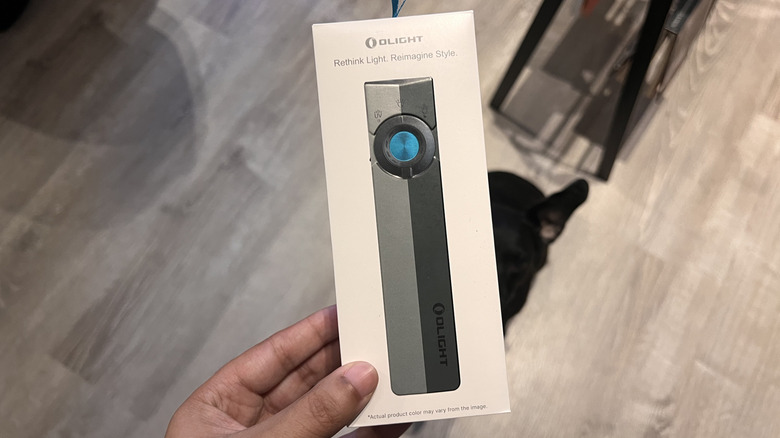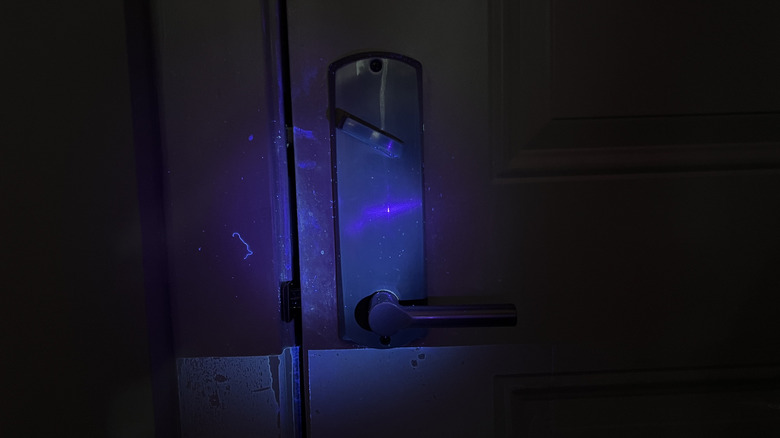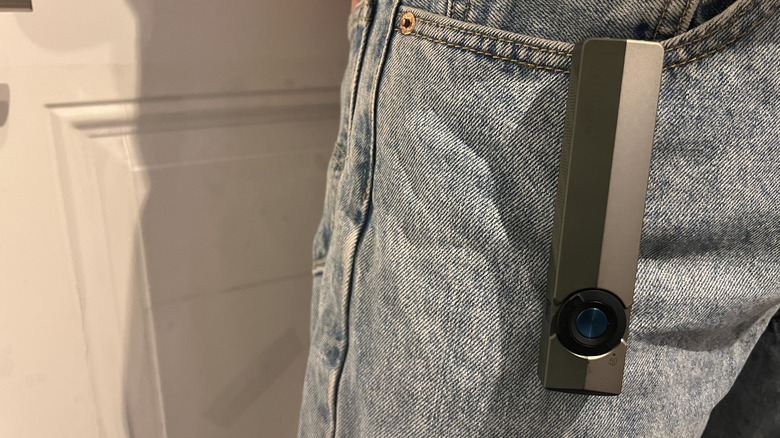Olight ArkPro Flashlight Review: The Bright Addition For Countryside Living
What type of person owns five flashlights, plus multiple other battery-powered lighting devices? Someone who has lived on the Gulf Coast, that's who. Living in hurricane-prone New Orleans for eight years has made me an expert on which emergency supplies every house should have. Hurricanes are bad enough without stumbling around in the dark, and relying on your phone's built-in flashlight is a waste of precious battery. I've generally grabbed whatever flashlight is cheapest at Walmart or Target, because a flashlight is just a flashlight, right?
That's what I used to think. Then I tried an Olight ArkPro, which looks nothing like the other flashlights I own and is significantly more ... well, nice. The ArkPro is a small, unassuming little device; if I stumbled upon it at random, I probably wouldn't peg it as a flashlight at all. It's what's known in the flashlight world as an EDC, or "everyday carry," a flashlight designed for daily portable lighting, which thus needs to be compact and versatile. The ArkPro is slim enough to fit in your pocket at just 16mm, with a clip on one side to keep it tucked in place. It offers seven lighting configurations, unibody construction, a max intensity of 10,640 Candela, and a max beam distance of 672 feet.
Olight sent me a free ArkPro flashlight in exchange for a no-strings-attached review. Ironically enough, I received it the very same day I got to my new home in Illinois — definitely not hurricane country — even so, I've kept all my flashlights, because you never know. I simulated a power outage to review the ArkPro and also tested its features and other settings. As I did so, I thought of my loved ones back in the South. Would I recommend the ArkPro for their emergency kits?
Unboxing the ArkPro and first impressions
It's safe to say that unboxing the ArkPro was a different experience than my other flashlight purchases. It felt more like unboxing an Apple product, with sleek packaging and handy arrows telling you what to do with your new toy straight out of the box. I had wondered if the aforementioned unibody construction, said to be more durable, was more for marketing than anything, but the ArkPro did feel far more sturdy and solid in my hand than the cheap flashlights I was used to — and fewer parts should mean fewer points of failure.
Other small details also made the ArkPro feel pleasant and easy to use straight out of the box. For example, there was a labeled diagram affixed to the control pad, so I quickly figured out how to reach all the different lighting modes. The only two things I had to look up were how to adjust the brightness (hold or double click the "on" button) and how to activate the strobe setting (click the "on" button several times). Another pro: the battery life and brightness level are clearly marked on the control pad for your convenience.
One possible downside is that you'll have to charge the ArkPro before use; it can charge via magnet or USB-C, but the charger that came with it was magnetic. It was super strong — you could even hang the flashlight from the magnet, if you wanted. This was helpful for making sure the tiny device actually kept charging. I put the ArkPro on the charger, and when I checked back in an hour, it was fully charged. According to Olight, the ArkPro has a long-lasting battery with up to 26 days of usage at 30 minutes a day. I barely saw the battery life go down at all during my testing, so I'm inclined to believe this claim.
Testing the ArkPro in a simulated power outage
The ArkPro has four main lighting modes: a flood light, a spotlight, a UV light, and a laser that can be used simultaneously with any of the previous three. Per Olight, the flood light is designed for close-up area lighting, which is the mode I predicted would be most useful during power outages. The spotlight creates a more defined beam of light. The UV light can be used for spotting pet stains and other invisible-to-the-naked-eye elements, and the laser can be used to point out details from afar. There are several brightness levels, depending on the lighting mode you're using. My cheap, generic flashlights from the big-box stores were dimmer and had a shorter beam distance in comparison. At the same time, the brightness on the ArkPro starts low enough to suit a range of needs.
Clearly, this device is designed to go beyond just emergency usage. But to stay true to my goal, I began my testing by simulating a power outage. I found that, while my phone's flashlight was bright enough to get around in the dark, the ArkPro gets so bright that it could even double as a backup lantern or lamp if needed — one could simply hang the flashlight overhead or prop it in the corner to illuminate the entire room. As expected, in a power outage scenario, the flood light was the mode that I found most useful. It created a soft, widely dispersed light, whereas the spotlight mode creates a distinct circular beam in one spot. I also noticed that the ArkPro lacks a red light mode, which is common for many emergency flashlights to avoid eye strain — although some other models, like Olight's ArkPro Lite, do offer this.
Other features and uses for the ArkPro
I also tried out the ArkPro's features in several everyday settings. I used it in dark, unlit areas outdoors (to simulate camping or hiking) and tried out the UV light and laser in my apartment. Overall, I found the flashlight comfortable to hold and easy to use, though it takes a bit of time to get used to the single control button. Since it is so small and flat rather than round like most flashlights, it's a breeze to throw into any bag or pocket and take on the go.
The brightness and beam distance were just as impressive outdoors as they were indoors, and unsurprisingly, the ArkPro outperformed my other flashlights again. In an outdoor setting, the spotlight mode was also much more useful. This bright circular light would be ideal for working in the yard at night or any other time you need to see details from far away, like walking on a dark trail or recognizing an unknown person in the distance. I would opt to bring this flashlight with me to a campground over the others I own. The laser and UV light also worked well. The UV light has three brightness settings, and let's just say I'll never look at my apartment the same again (so much dust)!
The main thing I didn't love — and this applies to all the modes on the ArkPro — was that you have to cycle through each brightness setting to find the one you want. With a light that gets so bright, it's a jarring effect, especially if you have to do it multiple times to land on your preferred brightness. Additionally, the flashlight gets noticeably hot to the touch after using it for a few minutes.
Verdict: would I recommend the ArkPro?
This is, simply put, a really good flashlight. With all the pros I mentioned already — the high quality, compact size, various modes, and impressive brightness and beam distance — it's an excellent everyday carry device. If you live in a rural area, go camping often, or work in dark settings, the ArkPro may make your life a whole lot easier and safer. It's potentially a one-device way to add light to your DIY workspace. Simple tasks, like finding the right tool or seeing what's down the driveway, would become stress-free with this flashlight. The UV mode is also great for detailed cleaning at home.
As for hurricanes and other emergencies, I wouldn't confidently recommend the ArkPro to my loved ones on the Gulf Coast for one main reason: the price. At a base price of $110, it's probably too nice for the average emergency supply kit; while the features and sleek design are nice, not all of them are necessary in a storm. For $110, you could get multiple bright and efficient flashlights, which is more helpful for an emergency kit than having one flashlight that can do a bunch of things. The ArkPro is missing a red light mode and does not accept regular batteries, which could be an issue in a multi-day emergency. However, for those who need a reliable everyday flashlight and have the budget, the ArkPro is an excellent, dependable all-around device to keep in the toolbox.
Methodology
To make sure I gave the Olight a fair assessment in accordance with our House Digest Review Policy, I examined the device itself and took it through a few basic tests. Taking note of the setup process, I unboxed the product, learned the controls, and measured how long it took for the initial charge. I also considered how the ArkPro felt in my hands, how easily it fit into a pocket or small bag, and how easy it was to navigate the controls.
For the first test, since I can't summon a true power outage, I did the best I could: I turned the electricity off in my apartment at the main breaker and closed all of the blinds. I tested the ArkPro in the darkest rooms in my apartment, the living room and bathroom. I don't have professional light testing tools, but I used my visual judgment to compare the brightness, coverage width, and beam distance to my other flashlights, including the built-in light on my iPhone 13 Pro. I used each flashlight mode and brightness setting around my dark apartment, including the UV light and laser. I then followed the same process outdoors at night in areas with no streetlights, once again cycling through each mode and comparing it to my other flashlights.





